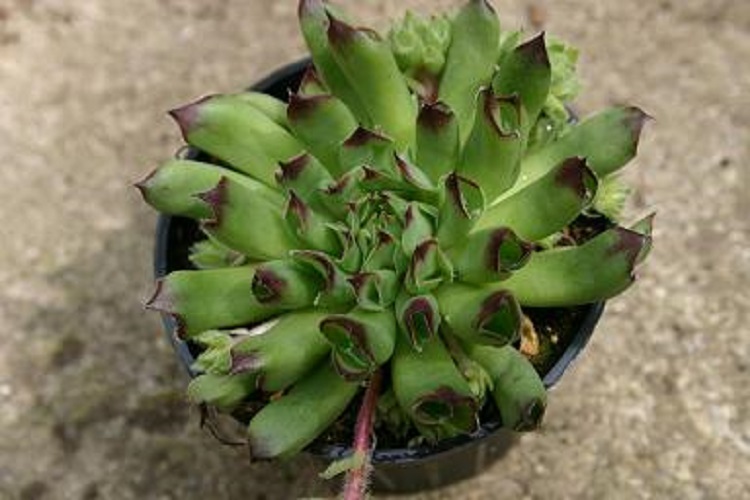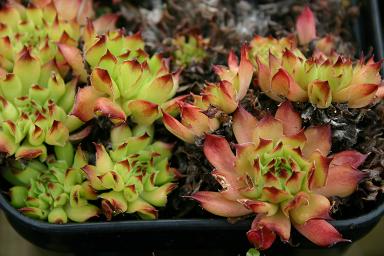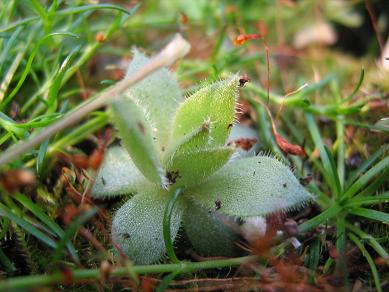The International Crassulaceae Network say:
"This is a monstrous mutation of Sempervivum calcareum, which has appeared in cultivation. It is not very vigorous and it flowers but very rarely.
It has been present in a few collections decades before it has been named and described in 1957.
First described in Nat. Cact.& Succ. Journal 12(4), p.72, 1957 by Ronald S. Byles as:
Sempervivum tectorum v. calcareum 'Grigg's Surprise' :
"Differs from v. calcareum proper in having more solid, denser rosettes, the leaves commonly deeper or more or less acutely concave on the undersides,
sometimes semi-cylindrical, usually less glaucous than in v. calcareum proper but otherwise strongly resembling that form in the apical mucro and
characteristic apical leaf marking. Inflorescence more or less fasciated or imperfect. Petals more or less aborting, cylindrical acuminate, tortuous,
flexible, very slender indeed, red-purplish pigmented but often remaining wholly or partly green. Carpels and stamens partly to wholly mature.
Whorl members frequently connate in pairs. Seeds sometimes fertile.
Origin: At present known only from cultivation where it may well have arisen by chance." "
The Llifle Encyclopedia says:
"has abnormal congested rosettes, leaves grey-green, round and hollow without an opening at the tip, each leaf ends in a red thorn-like beak, which is often double"
Writing in the Bulletin of the Alpine Garden Society in 1950, Will Ingwersen says:
"It seems high time that the muddle of the nomenclature of this curious plant was cleared up. The plant in question has been found in our gardens
for many years under such names as Cotyledon persicum, Cotyledon syriacum, Umbilicus persicus and Umbilicus syriacus
and finally, in an attempt to clear up these errors, when it was recognised from a flowering plant that it could not possibly be a Cotyledon
or Umbilicus, the provisional name of Sempervivum iranense was suggested for it. The flowers had all the characteristics of a
Sempervivum flower but on closer examination it was evident that all its sexual organs were malformed and quite unable to carry out
their normal functions.
This induced experiments and Mr Grigg took the plant in hand and subjected it to a treatment of special feeding which induced some of the rosettes
to change the curious, clubbed shape of the leaves into the flattened leaf of a normal Sempervivum. This is clearly seen in the photograph
in the Bulletin (Vol.xviii, p.18) where the big rosette on the extreme right shows almost complete reversion to the true,
sempervivoid leaf character.
Reverted rosettes have been separated from the clump and grown on separately and these maintained their normal leaf character and became indistinguishable
from the rosettes exhibited by Sempervivum tectorum var. calcareum. Finally some of these reverted rosettes flowered in every
way identically with Sempervivum tectorum var. calcareum and set seeds, which in the garden of Mr. Harris in Birmingham
produced normal Sempervivum tectorum var. calcareum as well as some few of the malformed plant known for so long under the
various erroneous names quoted above. In the garden of Mr. Nisbet at Gosport this reversion to a true sempervivoid character occurred
without artificial stimulation and there remains now no doubt that a curiously malformed plant has masqueraded in our gardens under a variety
of names. Who first attached these various wrong names appears unknown and there seems no excuse to connect either Persia or Syria
with this Sempervivum, and as far as present-day knowledge goes, no true Sempervivum is known to occur in either of these two countries.
Sempervivum tectorum var. calcareum is in nature confined to a few localities in the Maritime Alps.
Various notes and photographs about the research to establish the proper place of this plant have been deposited with
Mrs Vera Higgins and it is hoped that she may find the time to ventilate the matter further from the scientific standpoint in the pages of
the Bulletin.
The only correct name for this plant in its malformed state is Sempervivum tectorum var. calcareum forma monstrosum."
|



